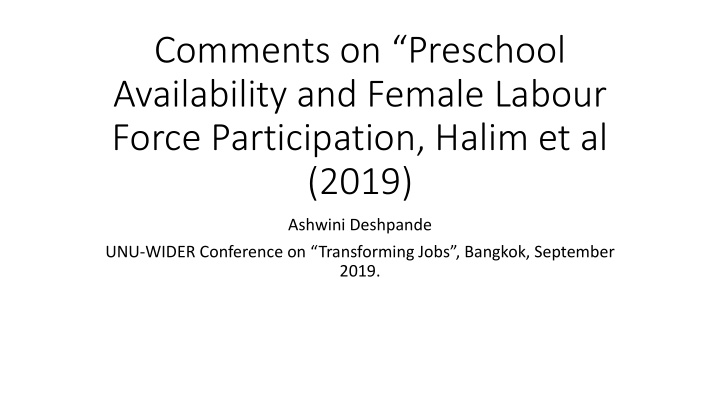



Comments on “Preschool Availability and Female Labour Force Participation, Halim et al (2019) Ashwini Deshpande UNU- WIDER Conference on “Transforming Jobs”, Bangkok, September 2019.
Early Childhood Education Services • Provision of preschools: massive benefits for children, but also the potential to increase maternal employment. • Test this in the context of Indonesia. • FLFP: 50.9% in 2016. • Authors view this as low; is lower than East Asian average, but higher than South Asia. • Pre-primary education: 25% (world avg: 32.1; regional avg: 43.3 and OECD avg: 73.3)
Policy Change in 2003 • National Education System Act (NSEA) in 2003. • Private and public provision increased • 2004: <1/4 th of children (3 to 6) attended preschool. • 2016: 60.3% • Authors exploit the spatial and temporal variations in preschool access to gauge the causal effects of preschool access on maternal employment.
Results • Mothers of preschool-aged children increase their work participation by 7.4 pp, or 13.8% from the mean, if they are exposed to an additional public preschool per 1000 children. • Private preschools do not have a statistically significant effect on work participation, but eligible mothers are more likely to hold a second job. • No effect on earnings or hours worked.
Paper: questions • Carefully done. • Figure 3: the trend in the growth in the density of public preschools doesn’t show a break in 2003; but that of private schools does. Yet the effect of public preschools is significant. • Public: WPR of mothers in high growth areas significantly higher than that in low growth areas in all years. • 2014 onwards: convergence? Effect tapering off? • Figure 5: WPR for high growth+ eligible > low+elig. • But WPR for high (low)+not eligible same and higher than both above.
Penalty of motherhood/childcare • Figure 6: mothers whose first child is preschool aged (3-6) have higher WPR compared to mothers whose first child is 0-2. • Preschool doesn’t fully take care of childcare constraints. • i.e. as a policy to push mothers back into the LF, or into the LF, we need childcare provisions earlier in the children’s life. • Figure 6: again, around 2013-14: convergence in WPR rates across different categories. • Why should provision of preschools affect mothers’ choice of industry? (Figure 8) (not formal/informal)
Larger questions • Paper finds that given preschools’ hours of operation, mothers take up unpaid family work and jobs as agricultural workers. • Preschools operate for less than half the day => tendency for women to take up informal work. • What is the ultimate goal? To record an increase in WPR or to create conditions for women to participate in substantive work? • Increase in FLFP, but in ways that increases their earning power and leads to economic empowerment → gender equality.
Evidence from other studies • Countries with higher affordable childcare have higher maternal employment rates. • Provision of childcare, esp preschools, helps mothers achieve a better work-life balance. • Caveats: scope of the policy limited in contexts where FLFP or affordable childcare is already high. • Or where affordable childcare services crowd out other forms of non- parental care. Quality of caregivers? • Norms about sharing domestic chores, childcare imp.
Recommend
More recommend